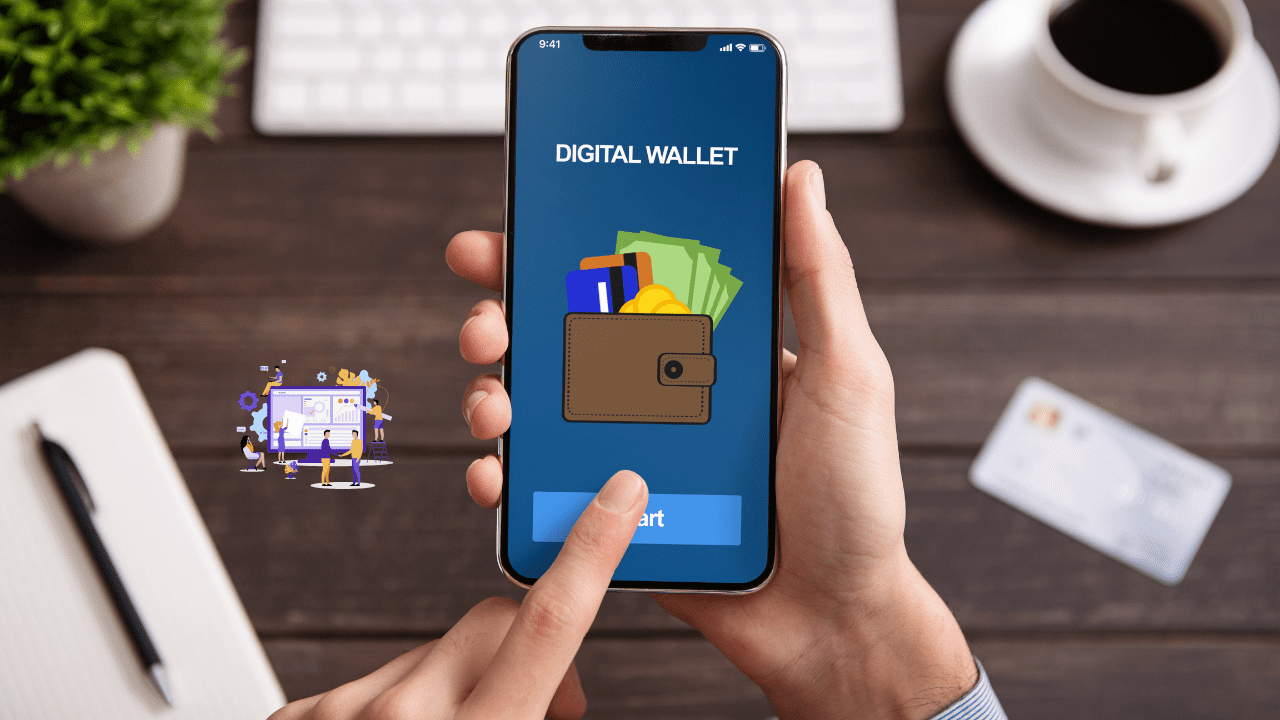1. The Rise of eWallets in the Digital Economy
In recent years, the world has witnessed an explosive shift from cash-based transactions to digital payments. Among these innovations, eWallets have emerged as a cornerstone of the modern fintech ecosystem. From paying utility bills to transferring money across borders, eWallets make transactions faster, safer, and more convenient.
- 1. The Rise of eWallets in the Digital Economy
- 2. What Is an eWallet App?
- 3. Why Businesses Need Custom eWallet App Development Services
- a. Unique Brand Identity
- b. Enhanced User Experience
- c. Better Scalability
- d. Integration Flexibility
- e. Security Control
- 4. Core Features of a Successful eWallet App
- 5. Advanced Technologies Behind eWallet Development
- a. Artificial Intelligence (AI)
- b. Blockchain Technology
- c. Near Field Communication (NFC)
- d. Cloud Infrastructure
- e. API Integrations
- 6. Step-by-Step Process: From Concept to Launch
- Step 1: Discovery & Planning
- Step 2: UI/UX Design
- Step 3: Backend & Frontend Development
- Step 4: Testing & QA
- Step 5: Deployment
- Step 6: Maintenance & Updates
- 7. Security Measures in eWallet App Development
- 8. Cost Factors and Timeline of eWallet App Development
- 9. Choosing the Right eWallet App Development Partner
- a. Proven Experience
- b. Technical Expertise
- c. Security Knowledge
- d. Transparent Pricing
- e. Client Testimonials
- 10. The Future of Custom eWallet Solutions
According to Statista, the global mobile wallet market is expected to surpass $12 trillion by 2026, reflecting just how integral these apps have become to daily financial life. For businesses, this shift presents a huge opportunity.
Building a custom eWallet app development services allows brands to tap into this rapidly growing digital economy while offering unique user experiences tailored to their audience.
2. What Is an eWallet App?
An eWallet app (or mobile wallet) is a digital tool that allows users to store, send, and receive money electronically. It eliminates the need for physical cash or cards and enables seamless financial management through smartphones.
Types of eWallets:
| Type | Description | Example |
| Open eWallets | Work with multiple merchants and allow withdrawals to bank accounts. | PayPal, Google Pay |
| Closed eWallets | Issued by a specific company; usable only for that company’s services. | Amazon Pay |
| Semi-Closed eWallets | Work with selected merchants and partners. | Paytm, Venmo |
Each type serves different user needs, but all share the same goal simplifying digital transactions while ensuring top-notch security.
3. Why Businesses Need Custom eWallet App Development Services
While there are many off-the-shelf payment apps, custom eWallet solutions stand out due to flexibility, branding, and functionality. Here’s why businesses should consider investing in custom development:
a. Unique Brand Identity
A custom app allows you to create a wallet that truly reflects your brand from UI/UX design to personalized features.
b. Enhanced User Experience
Businesses can tailor navigation, transaction flow, and design according to the preferences of their target users.
c. Better Scalability
As your customer base grows, a custom-built wallet can easily scale to handle higher transaction volumes.
d. Integration Flexibility
You can integrate loyalty programs, crypto wallets, APIs, or third-party services without restrictions.
e. Security Control
Custom development gives you complete control over data encryption, authentication layers, and regulatory compliance. In short, a custom eWallet helps businesses build trust, convenience, and loyalty three pillars of digital success.
4. Core Features of a Successful eWallet App
A great eWallet combines innovation with simplicity. Below are the must-have features every successful eWallet should include:
Essential Features
- User Registration & Profile Management
Easy onboarding with OTP, email, or social login. - Add/Withdraw Money
Integration with credit/debit cards and banks. - Transaction History
Users can view detailed logs for each transaction. - QR Code Payments
Enables instant in-store or peer-to-peer payments. - Bill Payments & Recharges
Convenient utility, mobile, and internet bill settlements. - Push Notifications
Real-time alerts for transactions, offers, and promotions.
Advanced Features
- Biometric Authentication (Face/Fingerprint ID)
Adds an extra layer of security. - AI-Based Fraud Detection
Automatically detects suspicious activity. - Cryptocurrency Integration
Supports Bitcoin, Ethereum, or other tokens. - Loyalty Rewards & Cashback
Encourages repeat usage and customer retention.
| Feature Type | Example | Benefit |
| Security | Fingerprint, OTP | Prevents unauthorized access |
| Convenience | QR payments | Faster checkouts |
| Personalization | Rewards | Enhances engagement |
5. Advanced Technologies Behind eWallet Development
The backbone of any robust eWallet lies in the technologies that power it. Let’s look at some key components:
a. Artificial Intelligence (AI)
AI enables smart analytics, user behavior prediction, and fraud detection, helping businesses personalize experiences and enhance safety.
b. Blockchain Technology
Blockchain ensures transparent, tamper-proof transactions and supports cryptocurrency integration.
c. Near Field Communication (NFC)
NFC allows users to make contactless payments by simply tapping their phones at terminals.
d. Cloud Infrastructure
Cloud-based hosting ensures scalability and real-time data access across platforms.
e. API Integrations
APIs connect your app with third-party banks, KYC systems, and payment gateways for smoother operations. Combining these technologies ensures that your app remains future-proof, secure, and efficient.
6. Step-by-Step Process: From Concept to Launch
Developing an eWallet app is a structured process that involves multiple stages. Below is a simplified breakdown:
Step 1: Discovery & Planning
- Identify target users, goals, and competitors.
- Define required features and compliance needs (e.g., PCI DSS, GDPR).
Step 2: UI/UX Design
- Create intuitive wireframes and user interfaces.
- Focus on simplicity, speed, and security for optimal user experience.
Step 3: Backend & Frontend Development
- Developers write secure code and integrate databases, APIs, and payment systems.
- Frontend developers ensure smooth, responsive designs.
Step 4: Testing & QA
- Conduct multiple tests performance, usability, and security to detect bugs and vulnerabilities.
Step 5: Deployment
- Launch on Google Play and App Store after meeting all technical and compliance requirements.
Step 6: Maintenance & Updates
- Regularly update the app with new features and fix emerging issues to maintain smooth performance.
| Phase | Key Tasks | Outcome |
| Planning | Requirement analysis | Clear project roadmap |
| Design | UI/UX wireframes | Engaging user interface |
| Development | Coding, integration | Functional product |
| Testing | QA, debugging | Stable release |
| Launch | App store submission | Market-ready solution |
7. Security Measures in eWallet App Development
Security is the backbone of every digital wallet. Users entrust your app with sensitive financial data, so you must implement top-level protection.
Key Security Practices
- Data Encryption: Protects sensitive information during transactions.
- Two-Factor Authentication (2FA): Adds a verification step for user logins.
- Tokenization: Replaces card details with encrypted tokens.
- Anti-Fraud Systems: Detects suspicious activity in real-time.
- Regulatory Compliance: Adheres to PCI DSS, GDPR, and AML/KYC standards.
Remember: A single data breach can damage both your brand and customer trust invest in preventive security from day one.
8. Cost Factors and Timeline of eWallet App Development
The cost of developing varies widely depending on several factors:
| Factor | Description | Impact on Cost |
| App Complexity | Number of features, integrations, and platforms | High |
| Design Quality | Custom design, animations, and UX | Medium |
| Technology Stack | Use of blockchain, AI, or NFC | High |
| Development Region | Developer location (USA vs Asia) | High |
| Maintenance | Post-launch support and updates | Medium |
Average Cost Estimates
- Basic eWallet App: $25,000 – $40,000
- Mid-Level App: $50,000 – $80,000
- Enterprise-Grade Solution: $100,000+
Timeline Overview
| Stage | Duration |
| Research & Planning | 2–3 weeks |
| Design & Prototyping | 3–4 weeks |
| Development | 8–12 weeks |
| Testing & Launch | 3–5 weeks |
| Maintenance | Ongoing |
Tip: Partnering with an experienced app development company helps you control costs without compromising quality.
9. Choosing the Right eWallet App Development Partner
Selecting the right technology partner can make or break your project. Here’s what to look for:
a. Proven Experience
Choose a company with previous eWallet or fintech development experience.
b. Technical Expertise
Check if they use modern tech stacks like Flutter, React Native, Node.js, and AWS.
c. Security Knowledge
Ensure they follow industry-grade encryption and compliance standards.
d. Transparent Pricing
A trustworthy partner provides clear cost breakdowns without hidden charges.
e. Client Testimonials
Review case studies or feedback from previous clients to gauge reliability.
| Criteria | Why It Matters |
| Experience | Ensures faster, smoother project execution |
| Tech Skills | Supports scalability and innovation |
| Security | Protects user trust and compliance |
| Communication | Keeps project aligned with goals |
10. The Future of Custom eWallet Solutions
The world is moving swiftly toward cashless and contactless transactions, and businesses that adapt now will gain a significant edge. By investing in custom eWallet app development services, you’re not just building an app, you’re creating a complete digital payment ecosystem tailored to your customers’ needs.
With the right strategy, security, and technology partner, your business can launch a scalable, secure, and future-ready Wallet that users love to use every day. From concept to launch every step you take brings you closer to shaping the future of digital finance.




